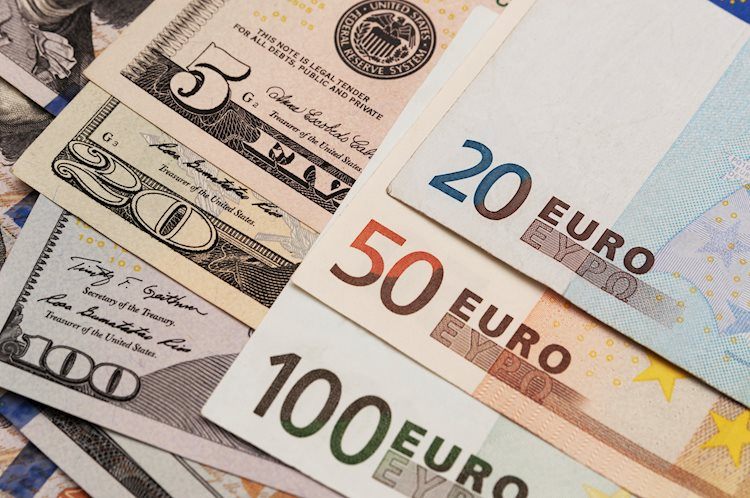- EUR/USD is trading close to 1.0600 early on Tuesday, maintaining its oversold status in the short term.
- Later today, Fed Chairman Powell will address the economic outlook and policymaking.
After a brief recovery effort in European trading, EUR/USD lost momentum and ended the first day of the week in negative territory. The pair is struggling to bounce back and is currently hovering around 1.0600 early on Tuesday.
Geopolitical tensions easing helped limit the upside of the US Dollar (USD) on Monday, supporting a slight uptick in EUR/USD. However, stronger-than-expected growth data from the US in March led to a surge in US Treasury bond yields, bolstering the USD.
In related news, Federal Reserve (Fed) Bank of San Francisco President Mary Daly emphasized the need for confidence in inflation reaching the 2% target before considering policy adjustments.
Euro Performance This Week
The table below illustrates the percentage changes of the Euro (EUR) against major currencies this week, with the Euro showing weakness against the Swiss Franc.
| USD | EUR | GBP | CAD | AUD | JPY | NZD | CHF | |
|---|---|---|---|---|---|---|---|---|
| USD | 0.31% | 0.19% | 0.26% | 0.86% | 0.73% | 0.93% | -0.07% | |
| EUR | -0.31% | -0.12% | -0.04% | 0.56% | 0.42% | 0.63% | -0.38% | |
| GBP | -0.20% | 0.11% | 0.07% | 0.66% | 0.53% | 0.74% | -0.27% | |
| CAD | -0.28% | 0.03% | -0.09% | 0.59% | 0.45% | 0.66% | -0.35% | |
| AUD | -0.87% | -0.56% | -0.68% | -0.59% | -0.13% | 0.07% | -0.93% | |
| JPY | -0.71% | -0.41% | -0.51% | -0.46% | 0.14% | 0.23% | -0.80% | |
| NZD | -0.94% | -0.63% | -0.77% | -0.67% | -0.07% | -0.21% | -1.01% | |
| CHF | 0.07% | 0.38% | 0.27% | 0.34% | 0.93% | 0.80% | 1.01% |
The heat map visually represents the percentage changes of major currencies against each other. The Euro is the base currency selected from the left column, with the quote currency chosen from the top row. For instance, the box at the intersection of Euro and Japanese Yen indicates the percentage change between EUR (base) and JPY (quote).
On Tuesday, the US economic calendar will feature Housing Starts and Building Permits data for March. Subsequently, the Fed, along with Bank of Canada Governor Tiff Macklem, will discuss the economic outlook and monetary policy during the American session.
Market analysis suggests an approximately 80% likelihood that the Fed will maintain the policy rate in June, indicating potential upside for the USD if Powell adopts a hawkish stance.
Furthermore, US stock index futures are trading negatively. Continued downward pressure on Wall Street’s main indices following Monday’s decline could prompt safe-haven flows towards the USD, posing challenges for EUR/USD.
EUR/USD Technical Analysis
EUR/USD saw a slight uptick after testing 1.0600, with the Relative Strength Index (RSI) on the 4-hour chart hovering near 20, signaling ongoing oversold conditions.
To the upside, initial resistance lies at 1.0660 (static level) followed by 1.0700 (psychological level, static level). Conversely, a breach below 1.0600 confirming it as resistance may lead to 1.0550 (static level from October) as the next support, followed by 1.0500 (psychological level, static level).
Euro FAQs
The Euro serves as the currency for 20 European Union countries within the Eurozone, ranking as the second most traded currency globally after the US Dollar. In 2022, it represented 31% of all foreign exchange transactions, with a daily turnover exceeding $2.2 trillion. Notably, EUR/USD stands out as the most traded currency pair worldwide, accounting for an estimated 30% of all transactions, trailed by EUR/JPY (4%), EUR/GBP (3%), and EUR/AUD (2%).
The European Central Bank (ECB) in Frankfurt, Germany, acts as the reserve bank for the Eurozone, overseeing interest rate settings and monetary policy management. The ECB’s primary objective revolves around maintaining price stability by controlling inflation or fostering growth through interest rate adjustments. Key decisions are made by the ECB Governing Council, comprising heads of Eurozone national banks and six permanent members, including the ECB President, Christine Lagarde.
Eurozone inflation data, measured by the Harmonized Index of Consumer Prices (HICP), holds significance for the Euro’s performance. Elevated inflation levels, especially surpassing the ECB’s 2% target, may necessitate interest rate hikes to curb inflationary pressures. Generally, higher interest rates or expectations thereof tend to bolster the Euro’s value. Economic indicators such as GDP, PMIs, employment figures, and consumer sentiment surveys play a pivotal role in influencing the Euro’s trajectory, with data from major Eurozone economies like Germany, France, Italy, and Spain carrying substantial weight due to their contribution to the region’s economy.
Additionally, the Trade Balance data serves as a crucial indicator for the Euro, reflecting the disparity between export earnings and import expenditures over a specific period. A positive net Trade Balance enhances a currency’s value by attracting foreign demand for exports. Hence, a strong trade surplus strengthens a currency, while a deficit has the opposite effect.
